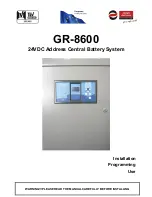
Date
26/6/2017
Document 923860006_09_006
Document code 923860006_09_006
Page 12 from 44
2.7 Powering On
Before powering on the device, reassure that the batteries and the mains power cord are connected with
correct
polarity
and the battery fuse is
unplugged.
Then turn on the green switch (
mains power switch
)
.
The switch must light on and the panel starts up. The system goes on a brief self-test while the message “CBS-
24V/AD/R, Ver.x.xx, PLEASE WAIT” appears on screen. When it’s done, main screen appears. It’s now safe to
plug the battery fuse (30A). The fault “BATTERY, FUSE FAULT” should appear on screen, but it will disappear in a
minute or less from the time the battery fuse is plugged in.
2.8 Configuring initial installation
The following 3 actions are crucial to be done after initial installation for the proper operation. These steps
have to be done when new luminaries are installed to or removed from the whole installation also.
i) AUTODETECT LUMINARIES
This is the first step needed to be made in order for the system to auto-
detect all connected points in the installation. The system goes on an automatic scanning and registers
every connected point to its memory. After autodetect takes place, every illumination zone operates in
maintained mode and every luminary will light. This is an assisting function to confirm which of the
luminaries are detected. Every successfully installed luminary will light. If a single luminary or a group
of luminaries are not lighting there may be a problem, such as a faulty connection, conflicted
addresses (same addresses in a zone) or the address set in that point(s) may be invalid. In that
occasion the operation AUTODETECT LUMI/RIES has to be done again after fixing the problem.
For AUTODETECT LUMI/RIES operation see 4.1.1.
ii) CHECK CURRENT ZONES
This procedure is a tool to determine if the load installed in a zone
exceeds the permitted values. The maximum load in a zone should not exceed 75W. When the system
detects a zone with a load current at 3.5A or more, then a fault message is displayed. This message
cannot be reset unless the load is adjusted correctly and the operation CHECK CURRENT ZONES
takes place again.
For CHECK CURRENT ZONES operation see 4.1.1.
iii) IDLE ZONES
This operation is also critical in order to ensure proper communication between the panel
and the luminaries. When this function is selected, all communications shut off, and there is no voltage
modulation on the power lines. This helps the installer to check the voltage drop on the last point of
each illumination circuit (zone). When the cable powering the luminaries is installed according to the
table on par 2.2, then there should be a voltage drop less than 3.5V. Voltage drop more than 3.5V can
cause communication issues. (The voltage supply when mains power is active is 25V, this means that
on the last point of each line the voltage should be at least 21.5V).
For IDLE ZONES operation see 4.1.1
iv) SET BATTERY CURRENT
This procedure is also significant for the system to calculate the output
current (sourced by the battery). When this action takes place, the system acts like in emergency mode
and the electrical current value (in Amperes) that the illumination circuits draw from the battery is
stored in the system memory. Each time the system goes in emergency mode the current consumption
is compared to the stored values and if there is more current drawn than the initial configuration then a
related message is displayed.
For SET BATTERY CURRENT operation see 4.1.1
Due to AUTODETECT LUMINARIES procedure, all the luminaries in every zone will operate in
maintained mode. To change mode to a whole zone (all luminaries) to non-maintained with one action,
you can use the SETUP LUMINARIES option and then select NON MAINTAINED in the desired zone.
For SETUP LUMINARIES function see 4.1.1.



























